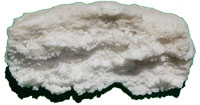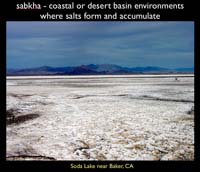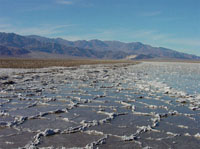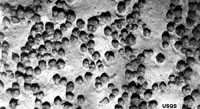6.3: Hydrogenous Sediments
- Page ID
- 9975
Hydrogenous Sediments
Hydrogenous sediments are sediments directly precipitated from water. Examples include rocks called evaporites formed by the evaporation of salt bearing water (seawater or briny freshwater).
Evaporites (Salts)
An evaporite is a rock composed of salt minerals left behind by the evaporation of salty water. Examples include minerals halite [salt] (NaCl) and gypsum (CaSO4 • x H2O).
rock salt—a rock dominantly composed of sodium chloride (NaCl - the mineral halite; Figure 6.8). Rock salt is an evaporite formed in restricted basins with an inflow of seawater located in an arid environmental setting.
gypsum—a mineral composed of hydrous calcium sulfate (CaSO4-2H2O); an evaporite mineral used in the manufacture of plaster. Gypsum is deposited by concentrated seawater and by evaporation of freshwater in arid regions. Crystals of gypsum are common in soils in arid regions. If gypsum looses its water content, it is called anhydrite (Figure 6.9).
 |
 |
| Figure 6.8. Rock salt (halite) | Figure 6.9. Anhydrite gypsum. |
Salts are precipitated when sea water (or briny lake water) is concentrated by evaporation. Shorelines along the oceans in hot arid regions of the world are places where salt, gypsum and anhydrite are being deposited today. Places where salts (evaporites) are actively accumulation include around the Red Sea and Persian Gulf. Salt deposits are also forming in isolated, internally drained lake basins around the world including the Great Salt Lake in Utah and the Dead Sea.
Iron-manganese nodules form on the ocean bed (mostly in the deep Pacific) from the slow precipitation of metal oxides in the absence of other kinds of sediments. It may take many millions of years for an individual manganese nodule to grow on the deep seafloor. Deposits of them cover the seafloor only in regions located very far away from lithogenous sediment sources.






